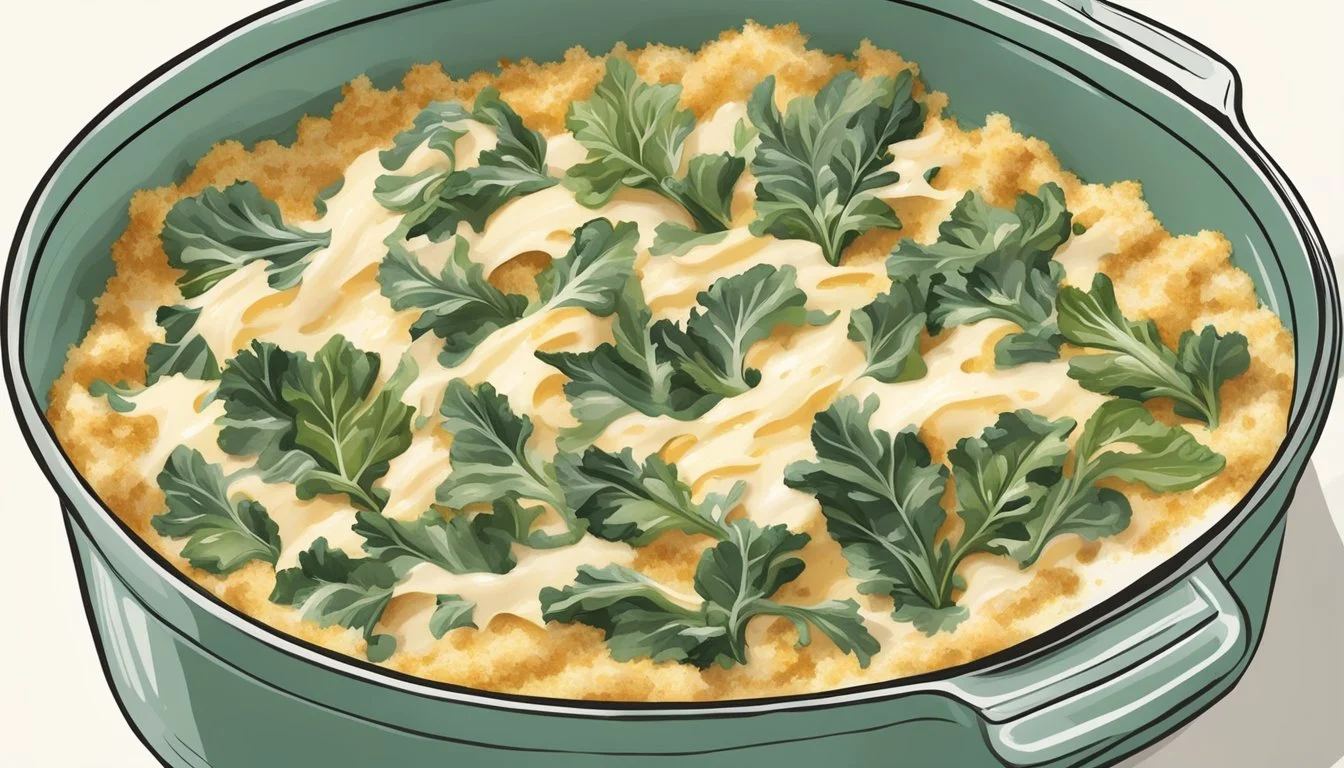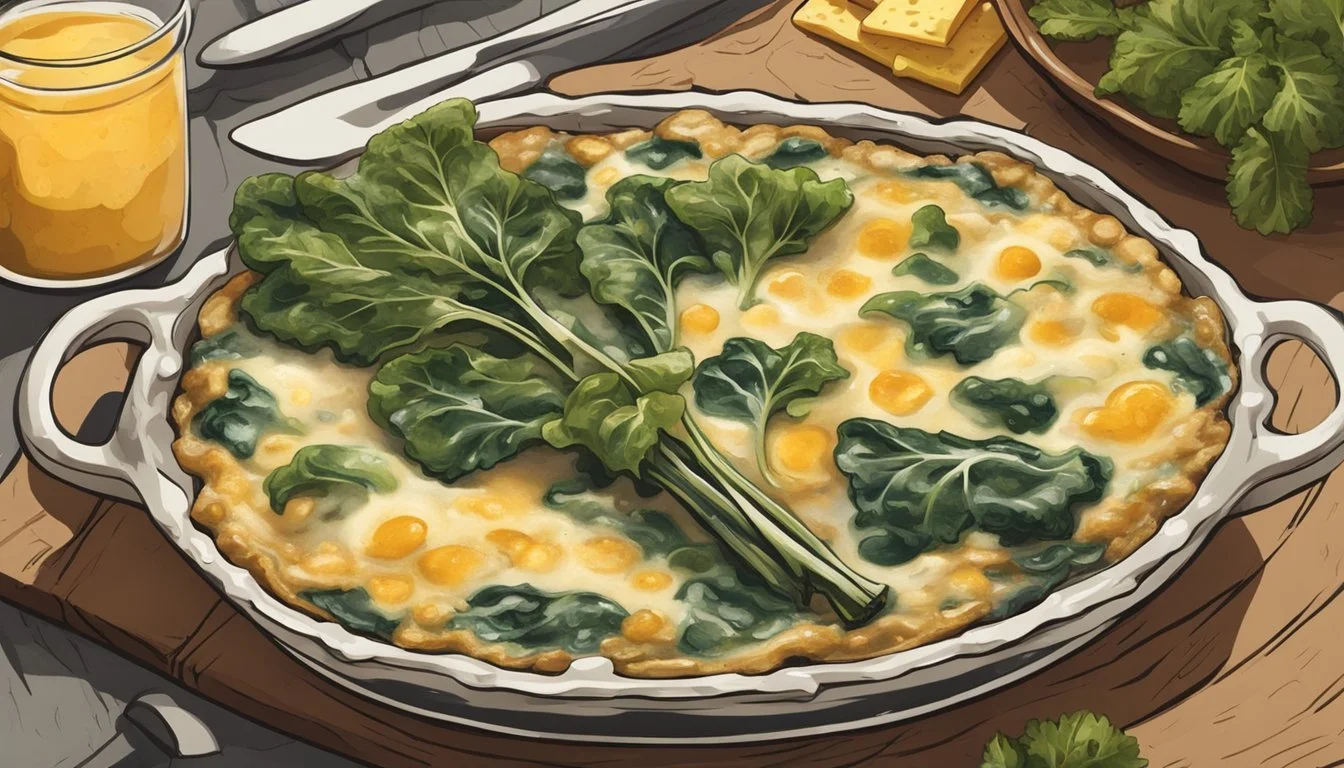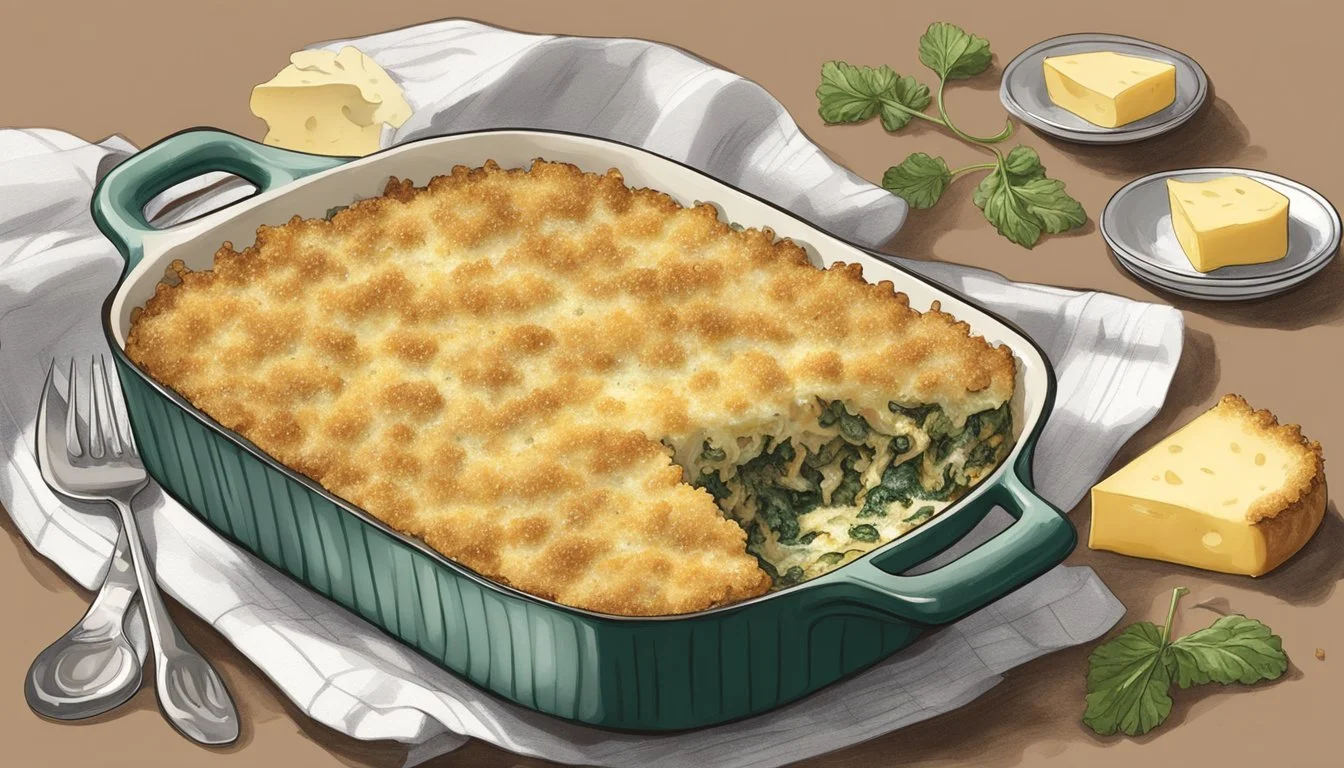Chard Stem Gratin
A Simple Recipe for a Cheesy, Comforting Side Dish
Chard stem gratin is a culinary creation that brings a touch of indulgence to the humble chard plant. This comforting side dish, featuring the often-overlooked chard stems, is transformed by a luscious cheese-laden sauce and a golden, crispy topping. Recognized for its versatility, the gratin provides a rich and satisfying accompaniment to a wide array of main courses, embracing the flavors of the kitchen with each cheesy bite.
The process of making chard stem gratin begins with the careful preparation of the stems, which are cut into pieces and sometimes blanched to tender perfection. They are then layered into a buttered ovenproof dish, awaiting the sumptuous addition of a creamy béchamel or cheese sauce. This creamy mixture, often infused with garlic and aromatic herbs, enrobes the stems, ensuring they are moist and flavorful.
The final touch to a chard stem gratin is the topping. A combination of breadcrumbs mixed with cheese and sometimes butter is sprinkled over the sauced stems, allowing it to form a deliciously crunchy crust as it bakes. When the gratin is placed into a hot oven, it bubbles and browns, resulting in a dish that is as delightful to behold as it is to taste. This gratin elevates the chard stems, incorporating them into a dish worthy of both weeknight dinners and special occasions alike.
Understanding Chard
Chard, known to some as Swiss chard, is a leafy green vegetable that is both versatile in the kitchen and rich in nutrients. It is in the same family as beets and spinach and offers a similar nutrient profile, including high levels of vitamins A, C, and K. The plant has large, fleshy, tender leaves and firm stems that vary in color from white for Swiss chard to bright yellow and red for rainbow chard.
One of the standout features of chard is its colorful stems, which offer not only visual appeal but also culinary versatility. The stems of Swiss chard are particularly noteworthy; they are thick, crunchy, and have a mild flavor that can complement a variety of dishes. Rainbow chard, true to its name, features stems in a variety of hues, including red, pink, orange, and purple, making it a vibrant addition to any plate.
When considering nutrition, chard is a powerhouse that provides an excellent source of fiber, antioxidants, and minerals. It's a beneficial addition to a balanced diet, supporting digestive health and providing essential nutrients without adding many calories.
Nutrient Benefit Vitamin A Supports vision and immune function Vitamin C Antioxidant vital for skin and overall health Vitamin K Essential for blood clotting and bone health Fiber Aids in digestion and maintains fullness
In culinary applications, chard can be utilized in its entirety, with both leaves and stems being edible. The leaves can be cooked down similarly to spinach, while the stems require a longer cooking time due to their fibrous texture. Chard is a great addition to a variety of veg-focused dishes, lending its nutritional benefits and robust flavor to the table.
Recipe Overview
Chard stem gratin is a dish that transforms the often-overlooked stems of chard into a creamy, cheesy side perfect for any table. This recipe embraces simple ingredients and straightforward cooking techniques to create a gratifying experience.
Ingredients:
Chard stems,
Milk,
Cream,
Garlic,
Butter,
Bread crumbs,
Parmesan cheese,
Salt and pepper.
One begins by preheating the oven to a specified temperature, typically around 200°C (392°F) or gas mark 6. An ovenproof dish is then buttered to ensure the gratin does not stick. The chard stems are cut from the leaves and further cut into bite-sized pieces.
The cooking process involves simmering the blend of milk, cream, garlic, and bay leaves until boiled. This infused liquid is then used to bathe the prepared chard stems. The baking dish receives a rub of garlic followed by a coating of butter, into which the chard stems are neatly placed.
The topping is equally important – a mix of bread crumbs and grated Parmesan cheese, combined with a touch of butter, is sprinkled over the stems. The dish is then cooked until the surface turns a golden brown, signaling a perfectly crispy top, which takes about 15 minutes.
Recipe Card:
Servings Oven Temperature Cooking Time Multiple 200°C (392°F) 15 min
Throughout cooking, the chard is treated delicately to preserve its unique texture and flavor. Precision in the recipe's timing and temperature ensures the gratin is neither undercooked nor burned, but just right – tender stems with a crisp, cheesy topping.
Preparation Essentials
In creating a delectable Chard Stem Gratin, selecting top-quality ingredients and having the right kitchen tools are crucial for a successful dish.
Ingredient Selection
Cheese: The key to a rich and flavorful gratin is the right mix of cheeses. A combination of Gruyère and Parmesan provides a perfect balance of nutty and sharp flavors. Pecorino can be used as an alternative to Parmesan.
Chard: Fresh chard stems are essential; they should be firm and vibrant in color. The leaves are often used as well, adding texture and nutrients to the dish.
Breadcrumbs: Opt for homemade or high-quality store-bought breadcrumbs for a crispy topping. They should be dry and finely ground.
Flour and Butter: All-purpose flour and unsalted butter are the basis for a traditional roux, which thickens the gratin sauce.
Herbs and Oil: Fresh thyme adds a subtle earthiness to the dish. Olive oil and butter are used for sautéing and to add rich flavor to the topping.
Garlic: Fresh garlic cloves bring an aromatic depth to the gratin. It should be finely minced or pressed.
Required Kitchen Equipment
Sauté Pan or Skillet: Needed for preparing the chard and to infuse the milk-based sauce with garlic and herbs.
Ovenproof Dish: A round or rectangular dish, approximately 30cm in diameter, is ideal for even baking.
Colander and Saucepan: Used for washing and boiling the chard, respectively.
Mixing Bowls: For combining the cheese and breadcrumb mixture.
Whisk: Essential for creating a smooth sauce, free of lumps.
Cheese Grater: A box grater or handheld grater works well for freshly grating cheese for better melting.
Each piece of equipment should be in good condition to ensure they perform their functions effectively.
Cooking Process
The cooking process for Chard Stem Gratin involves a series of steps: from preparing the chard, creating a luscious cheese sauce, to assembling and topping the dish before it's baked to perfection. Meticulous preparation and understanding the sequence of events are crucial for a successful gratin.
Chard Preparation
One begins by preheating the oven—usually to a temperature between 350 degrees Fahrenheit (175 degrees Celsius) and 400 degrees Fahrenheit (200 degrees Celsius). While the oven is warming, the chard is washed and processed. The chard stems are separated from the leaves and chopped into pieces. These pieces are then boiled in lightly salted water until they are tender. Following the boiling process, the stems are drained and the chard leaves are also given a quick blanch to wilt them before both are set aside to cool.
Cheese Sauce Creation
A béchamel sauce serves as the base for the cheese sauce and is prepared by melting butter in a saucepan. Flour is whisked into the melted butter to create a roux, which is cooked for a few minutes to remove any floury taste. Then, milk is gradually added while continuously whisking to prevent any lumps from forming. The sauce is cooked until thickened, and then cheese is incorporatd—most commonly a blend of sharp, melty cheeses like Gruyère or Cheddar—until melted and smooth. Seasonings such as salt and pepper are added to taste.
Assembly & Topping
A baking dish is buttered to ensure nothing sticks during the baking process. The chard stems and wilted leaves are layered into the dish, and the cheese béchamel sauce is poured over them. Additional cheese may be sprinkled on top for a richer crust. The gratin is then transferred to the oven and baked until the topping is golden and the sauce is bubbling at the edges. This not only ensures the chard is tender but also creates a visually appealing golden-brown crust atop the creamy béchamel sauce.
Baking Instructions
To create a delectable Chard Stem Gratin, follow these baking instructions with precision to ensure optimal results.
Preparation Steps:
Preheat the oven to 350 degrees F (175 degrees C) to establish an even cooking environment.
Use butter to generously coat the interior of an ovenproof baking dish. This prevents sticking and contributes to a golden finish.
Layering:
Place the parboiled chard stems evenly along the bottom of the dish.
Overlap with chard leaves to create a layered effect, pressing down slightly.
Pouring the Sauce:
Gently pour the creamy cheese sauce over the layers, ensuring even coverage.
Topping:
Combine bread crumbs with grated cheese. This mixture is often Parmesan for its sharpness and perfect melting quality.
Sprinkle the crumb mixture on top for a crisp finish.
Baking:
Place the dish in the oven. Bake until the surface turns golden and the sauce is visibly bubbling around the edges, indicating a thorough cook. Approximate time is 25–30 minutes, depending on oven variations.
To Finish:
Should you desire an extra crispness on your gratin, utilize the oven's broil setting carefully in the final few minutes of baking.
Monitor closely to avoid burning, looking for a rich, golden brown crust to form.
After removing from the oven, allow the gratin to rest for several minutes. This not only cools it to a suitable eating temperature but also gives the layers time to settle, making serving easier.
Serving Suggestions
Chard Stem Gratin is an excellent side dish that adds a comforting cheesy touch to various meals. Its rich, creamy texture pairs well with a variety of main courses and is particularly well-suited for winter holiday feasts.
Thanksgiving and Christmas:
During the festive holidays, a large spoonful of Chard Stem Gratin complements traditional main courses, such as:
Roast turkey
Baked ham
Prime rib roast
It can share the table with other popular holiday sides like mashed potatoes, cranberry sauce, and green bean casserole to create a well-rounded meal.
Pairs with Proteins:
For everyday dining, Chard Stem Gratin balances the flavors of hearty meat dishes. It goes particularly well with:
Grilled steak
Roasted chicken
For those preferring plant-based options, pairing it with a lentil loaf can be equally satisfying.
Accompaniment for Vegetables: To complete a vegetable-centric meal, serve Chard Stem Gratin alongside:
Glazed carrots
Sauteed green beans
This allows for a colorful plate with a medley of textures and flavors.
In short, Chard Stem Gratin is versatile and can enhance a casual family dinner as well as anchor a celebratory holiday spread. With its creamy consistency and layered flavors, it holds its own next to a variety of main courses.
Nutritional Information
Chard stem gratin is a dish that contains a variety of nutrients beneficial for a balanced diet. It provides a rich source of dietary fiber, largely attributed to the chard stems, which aids in digestion and promotes a feeling of fullness.
The cheese, which is a key component of this gratin, contributes to the calorie, fat, and protein content of the dish. Cheeses such as provolone or gruyère add a creamy texture and are packed with protein, which is essential for body repair and muscle growth.
A single serving of chard stem gratin typically contains the following nutritional values:
Calories: Variable depending on the type and amount of cheese and cream used
Carbohydrates: Moderate, as the main ingredients are vegetables and dairy
Fiber: High, due to the presence of chard stems
Sodium: Can be moderate to high; watch the amount of added salt
Fat: Mainly from cheese and cream; can be high in saturated fats
Protein: Good amount provided by the cheese
In terms of micronutrients, chard is a source of vitamins A, C, and K. The addition of ingredients such as nutmeg and garlic not only enhances flavor but also adds to the nutrition profile of the dish, with nutmeg providing trace amounts of minerals.
When preparing chard stem gratin, it's worth noting that:
Opting for low-fat cheeses can help reduce overall fat content.
Adjusting the portion size can help manage calorie intake if necessary.
In summary, chard stem gratin can be a nutritious side dish that offers several health benefits, especially when consumed as part of a well-rounded diet.
Storage & Reheating
For optimal freshness, chard stem gratin should be stored properly after cooking. Once it has cooled down, it can be placed in an airtight container. The gratin should be refrigerated within two hours of cooking to prevent bacteria growth. It will keep in the fridge for up to three to four days.
When it comes to reheating, the gratin should be warmed through but still moist inside. To ensure even heating and retain the dish's creamy texture, follow these steps:
Preheat your oven to 350°F (175°C).
Transfer the gratin into an oven-safe dish if it’s not in one already.
Cover the dish with aluminum foil to prevent the cheese from burning or becoming too dry.
Heat for about 20 minutes, checking halfway through.
For a crispy top:
Remove the foil during the last 5 minutes of reheating.
Reheating Step Temperature Time Note Preheat Oven 350°F (175°C) N/A Cover with Foil N/A N/A Prevents drying out and burning Bake N/A 20 minutes Check at 10 minutes For crispiness N/A Last 5 minutes Remove foil
To ensure the gratin heats evenly, stirring is not recommended as it can disrupt the layers of cheese and chard stems. Microwaving is also not advised as it can affect the texture, causing it to become soggy.
Alternative Variations
Chard stem gratin can be adapted to suit various dietary needs, including vegetarian and vegan preferences, without compromising on the richness and flavor that this dish offers.
Vegetarian Options
For vegetarians seeking protein-rich alternatives, cheeses such as Parmesan or Gruyere provide not only necessary protein but also contribute to the creamy texture of the gratin. Use of olive oil instead of butter is another variation that adds a slightly different flavor while keeping the dish vegetarian.
Cheese options:
Parmesan
Gruyere
Substitutes:
Feta (for a tangier taste)
Cooking fats:
Olive oil (instead of butter)
Clarified butter (for lactose-sensitive vegetarians)
Spinach often finds its way into chard stem gratin for vegetarians who desire an additional layer of flavor and nutrients. Spinach blends seamlessly with chard stems, creating a balanced medley of leafy greens.
Vegan Substitutes
Vegans can enjoy chard stem gratin by replacing dairy products with plant-based alternatives. Nutritional yeast and cashew cream can mimic the cheesy, creamy components, while offering a wholesome source of protein and other nutrients.
Dairy substitutes:
Nutritional yeast (for a cheesy flavor)
Cashew cream or other vegan cheese (for creaminess)
Unsweetened almond or soy milk (as a base for the sauce)
Cooking fats like olive oil can replace butter to sauté shallots or garlic, adding rich flavors to the base of the gratin. This substitution maintains the gratin's traditional taste profile in a vegan-friendly way.
Food Writer's Tips
In preparing Chard Stem Gratin as a side dish, accuracy and creativity are key. Food writers share valuable insights to elevate this dish from good to exceptional.
Chard Preparation: They emphasize the importance of thorough washing and peeling the chard stems. Cutting the stems into uniform pieces ensures an even cook.
Season Thoughtfully: Sea salt is a go-to for its coarse texture and pure taste. Adding just the right amount enhances the chard's natural flavor without overpowering it.
Oil Selection: A drizzle of extra virgin olive oil brings a depth of flavor. Its use in greasing the baking dish provides a subtle, fruity undertone that complements the chard's earthiness.
Cheese Matters: Although various recipes exist, food writers suggest a blend of cheeses for a balanced flavor profile and luxurious melt.
Cooking Tips:
Preheat your oven to maintain consistent temperature.
Layering the ingredients encourages an even distribution of flavors.
Bake until the top is golden and crisp, offering a textural contrast.
Step Tip Preheat Oven 200°C (392°F) to ensure a crispy topping Butter Dish Extra virgin olive oil can be used for greasing Seasoning Sea salt brings out the chard's flavor
Writers advocate for tasting as you go and adjusting the seasoning to personal preference. They remind home cooks that the simplicity of ingredients should speak for itself in this humble yet satisfying dish.
Common Questions
What is Chard Stem Gratin? Chard Stem Gratin is a baked side dish that uses the often-discarded stems of Swiss chard, combined with creamy sauce and cheese, and then broiled to a golden crisp.
Is Swiss chard the same as spinach? No, although they are both leafy greens, Swiss chard and spinach are different vegetables. Swiss chard has a slightly stronger, more earthy flavor and is known particularly for its colorful stems.
Can the chard leaves be included in the gratin? Yes, the leaves can be added to the gratin. They should be wilted before being mixed with the stems and other ingredients.
Ingredient Preparation Swiss chard Wash, separate stems, chop Onion & Garlic Finely dice, mince Cheese (e.g., Gruyère) Grate and set aside
How should one prepare the Swiss chard stems? Swiss chard stems should be washed, trimmed, and cut into pieces. They require a longer cooking time compared to the leaves, so they are usually prepared first.
At what temperature should the gratin be cooked? The dish should be baked at temperatures ranging from 375°F to 400°F (190°C to 200°C), depending on the recipe.
What type of cheese works best in a chard gratin? Gruyère is a popular choice for its melting qualities and rich flavor, but other cheeses like Parmesan or a sharp cheddar can also be used effectively.
Conclusion
Chard stem gratin epitomizes the essence of a resourceful and delightful side dish. This preparation allows cooks to use parts of the chard that might otherwise be discarded, demonstrating a sustainable approach to cooking. Chard stems, often overlooked, provide a crisp-tender texture and a slightly earthy flavor that pairs wonderfully with the richness of cheese and cream.
The versatility of the dish shines through in the various adaptations that can be made to the recipe. One can opt for a variety of cheeses such as Gruyère to infuse nuttiness or a sharper cheddar for that extra zest. Additionally, the inclusion of ingredients like garlic, onions, and aromatic bay leaves enhances the overall flavor profile.
The simplicity of preparation—a combination of sautéing, boiling, and baking—makes it an accessible option for both novices and experienced home cooks. What truly elevates chard stem gratin is the golden, crunchy breadcrumb topping, providing a pleasing textural contrast to the tender stems beneath.
When served, chard stem gratin not only adds a touch of elegance to the table with its creamy texture and inviting appearance but also offers a comforting taste experience. As such, it becomes an excellent accompaniment to a myriad of main courses, from simple roasts to elaborate holiday meals (What wine goes well with holiday meals?).
In essence, the gratin celebrates chard stems, transforming them into a dish worthy of savoring. It is a testament to how classic cooking techniques and a touch of creativity can elevate humble ingredients to new culinary heights.






